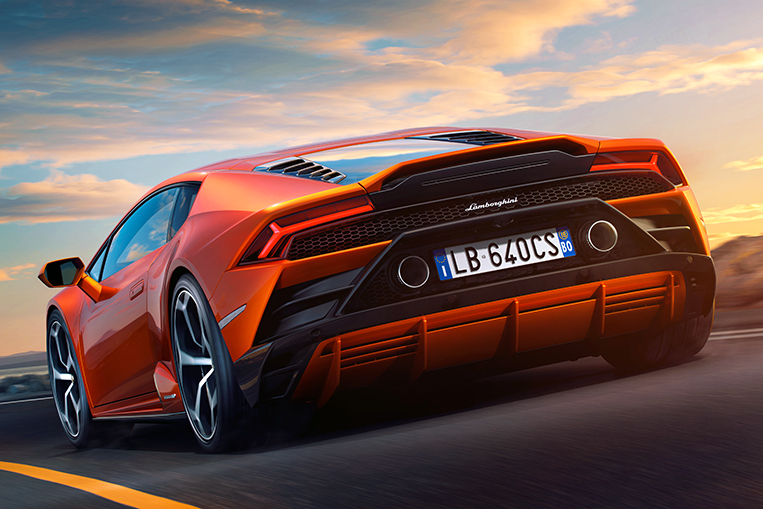
Sometimes you really have to wonder how product development at supercar companies works. Take Lamborghini for example. When the Huracán first came out, it already boasted a rather healthy 602hp, but someone still decided that it needed more. So, in 2017, the Huracán Performante was released. That came with 631hp and a bit more torque, but again some slightly crazed person in an Italian boardroom looked at it and went: “It must be faster!” Fast-forward to today and here it is: the Lamborghini Huracán Evo, the fastest, meanest version of this car yet. Until the next guy in a suit shouts that it needs to be even faster.
On the design side, the Huracán Evo has received a new front bumper and a slightly redesigned rear that prominently features the twin outlets of the new exhaust system. The cabin comes with all the creature comforts multimillionaire sports-car owners are looking for these days, including an 8.4-inch HMI capacitive touchscreen, smartphone connectivity, plush Alcantara seats and even an optional dual-camera telemetry system to record any driving antics for posterity. The package is rounded off by the new Arancio Xanto orange paint job and a set of new 20-inch Aesir wheels fitted with Pirelli P Zero tires.

The 5.2-liter naturally aspirated V10 aluminum pressure cooker now delivers 640hp at 8,000rpm, served with a side of 600Nm of torque. With the car having a dry weight of 1,422kg, this means that each horse has to move just 2.22kg. This generous combination is enough for whiplash-inducing sprint from zero to 100km/h in just 2.9 seconds, with the run from rest to 200km/h over and done with in just 9.0 seconds. The top speed is set at 325km/h. Throw an anchor at 100km/h and you’ll be stationary again in just 31.9m. All pretty impressive, but the real killer features are found elsewhere on the car.

Lamborghini clearly knows that many of its customers might have the cash needed to buy a superfast rocket on wheels, but do not necessarily possess the driving skills to put all that power down on the tarmac without eventually making themselves look a bit foolish. So the Italians have gone and developed a whole bunch of clever electronic systems to keep things in check. And to make these sound less like the electronic babysitters that they really are, the firm has slapped some mighty-sounding Italian names on them. Take a deep breath, for here are a few proper tongue-twisters for you.
The first item is called the Lamborghini Dinamica Veicolo Integrata (or LDVI). This is the new electronic brain of the car that controls all of its dynamic systems and makes sure that the setup is always right and the vehicle can more or less anticipate what the driver will do next. Then there is the Lamborghini Piattaforma Inerziale (or LPI), a bunch of accelerators and gyroscope sensors that sit at the car’s center of gravity and constantly monitor things like lateral, longitudinal and vertical accelerations, as well as roll, pitch and yaw rates. This helps the magneto-rheological suspension adapt to changes as needed, while a new traction control system, the all-wheel-drive setup and a torque vectoring feature make sure that the car always travels fast and in the right direction.

Speaking of directions: The steering system has also been given the once-over and now features enhanced Lamborghini Dynamic Steering (or LDS). The company claims that this, coupled with rear-wheel steering, will make the Huracán Evo more responsive and stable when the pedal hits the metal. What all these systems really mean is that the car is not only extremely fast at the hands of an expert driver, but also holds the ability to make you look like Valentino Balboni behind the wheel. The only real challenge left is producing the money to cover the €184,034 (P 11.1 million) price tag (before taxes).











Comments